Overview
Tech startups often face the challenge of enhancing user experience, a critical aspect that can make or break their success. Many founders may feel overwhelmed by the complexity of understanding user needs and behaviors. This struggle can lead to frustration, as neglecting user experience can hinder product refinement and diminish customer satisfaction and loyalty.
However, there is hope. By employing nine essential UX research methods—such as user interviews, surveys, usability testing, and A/B testing—founders can gain a deeper understanding of their users. These methods not only refine products but also foster a sense of connection with customers, ultimately driving business success in a competitive landscape.
Remember, you are not alone in this journey; embracing these strategies can pave the way for a more satisfying and successful user experience, nurturing both your product and your relationship with users.
Introduction
Starting a tech startup often feels like navigating a labyrinth, and many founders find themselves struggling to truly understand their users' needs amid the chaos of product development. This disconnect can be disheartening, hindering innovation and leading to missed opportunities in a fiercely competitive landscape. Imagine the frustration of pouring your heart into a product, only to realize it doesn’t resonate with those you aim to serve.
By exploring nine essential UX research methods, startups can unlock invaluable insights that not only enhance user experience but also drive sustainable growth. What if the key to transforming your fledgling tech venture lies in understanding the intricate dance between user feedback and product design? Embracing this journey may offer the clarity and direction you need to thrive.
RNO1: Comprehensive UX Research Strategies for Tech Startups
Starting a tech venture can be daunting. Many founders grapple with understanding their users' true needs and navigating the complexities of product development. This struggle can lead to frustration and uncertainty, leaving them feeling disconnected from their audience.
At RNO1, we understand these challenges deeply. Our diverse array of UX research methods is specifically designed for technology companies, emphasizing user-centered design principles, iterative testing, and data-driven decision-making. By prioritizing the comprehension of consumer needs and behaviors, we empower new ventures to create products that genuinely resonate with their intended audience.
This nurturing approach not only fosters innovation but also helps new businesses maintain a competitive edge in the fast-paced technology landscape. The focus on user-centered design is essential; it enhances customer satisfaction and loyalty, ultimately driving business success.
Moreover, our integration of advanced analytics allows new businesses to continuously refine their offerings, adapting effectively to user feedback and market trends. RNO1's services—including Digital Strategy, UX & UI Design, and Web & App Development—are tailored to address the unique challenges new businesses face, such as time and budget constraints.
By leveraging these services, startups can enhance their branding and identity, which are vital for standing out in a crowded market. We invite you to share your experiences and connect with us as we work together to turn your vision into reality.
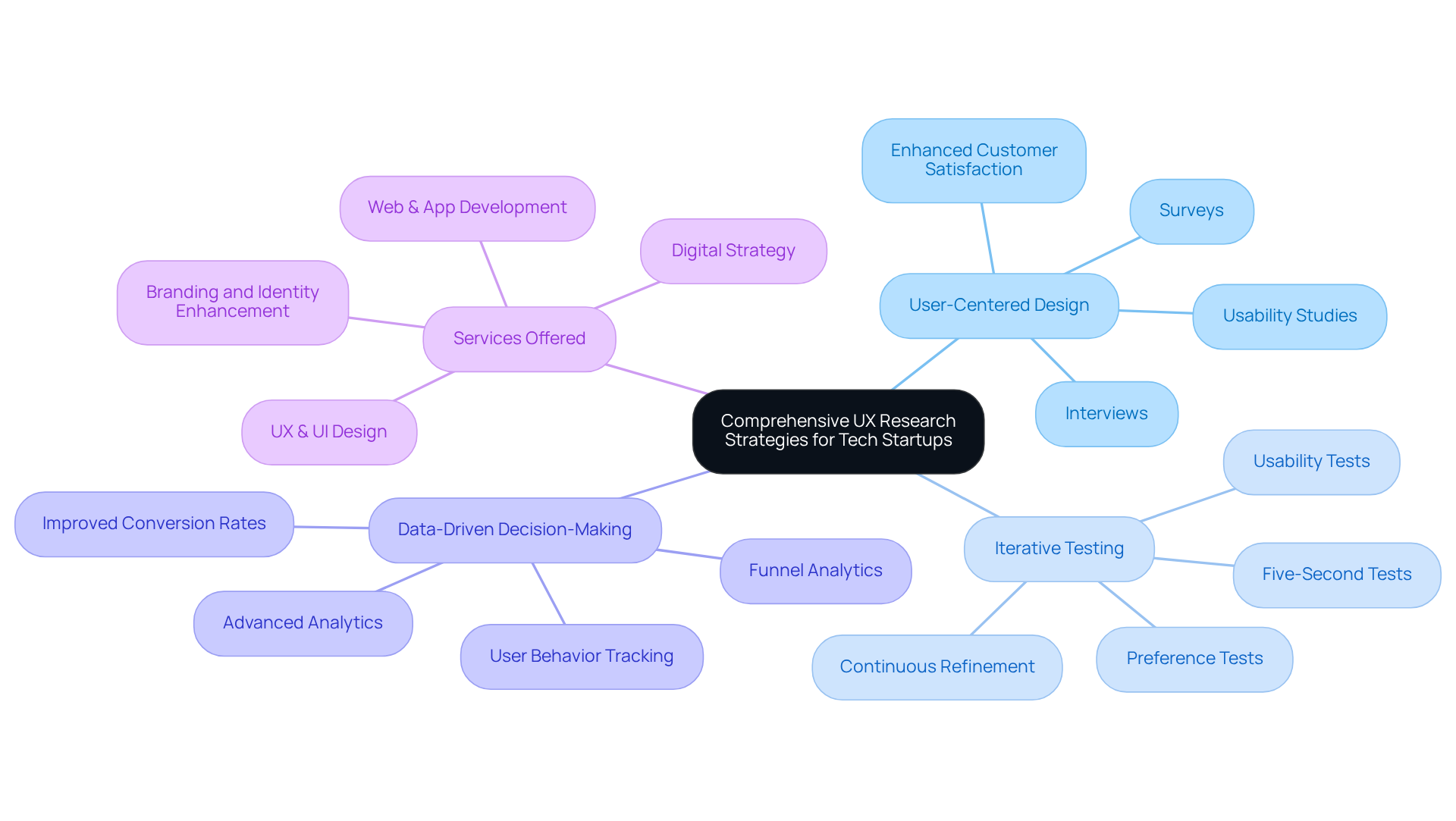
User Interviews: Direct Insights from Your Target Audience
Client interviews are an important example of UX research methods for technology ventures, providing individual conversations that explore clients' experiences and expectations. Many startups struggle to truly understand their audience, which can be addressed by using effective UX research methods, leading to fewer missed opportunities for growth and connection. By employing open-ended questions as part of their UX research methods, startups can create a space that encourages participants to share their thoughts freely, yielding qualitative data that often uncovers insights overlooked by quantitative methods. This approach not only aids in refining offerings to better meet consumer needs but also employs UX research methods to foster a deeper understanding of the intended audience.
Consider the impact: studies reveal that companies prioritizing customer insights can achieve a 32% increase in cross-selling and up-selling. This statistic underscores the tangible benefits of integrating consumer feedback into the development process. Moreover, utilizing UX research methods such as regular participant interviews cultivates a continuous cycle of enhancement, enabling new ventures to adapt swiftly to emerging trends and shifting audience preferences. Establishing a consistent schedule for conducting these interviews with UX research methods ensures a steady flow of fresh insights, vital for ongoing product improvement.
Creating a welcoming interview environment is equally important in UX research methods, as it significantly influences the quality of responses. When clients feel comfortable, they are more likely to share candidly, which enriches the data collected through UX research methods. Consequently, new businesses that effectively utilize UX research methods, such as client interviews, are better positioned to elevate customer satisfaction and loyalty, ultimately steering towards sustainable growth. By embracing this nurturing approach, tech startups can transform their understanding of clients into meaningful action, fostering a community that thrives on shared insights and collaborative improvement.
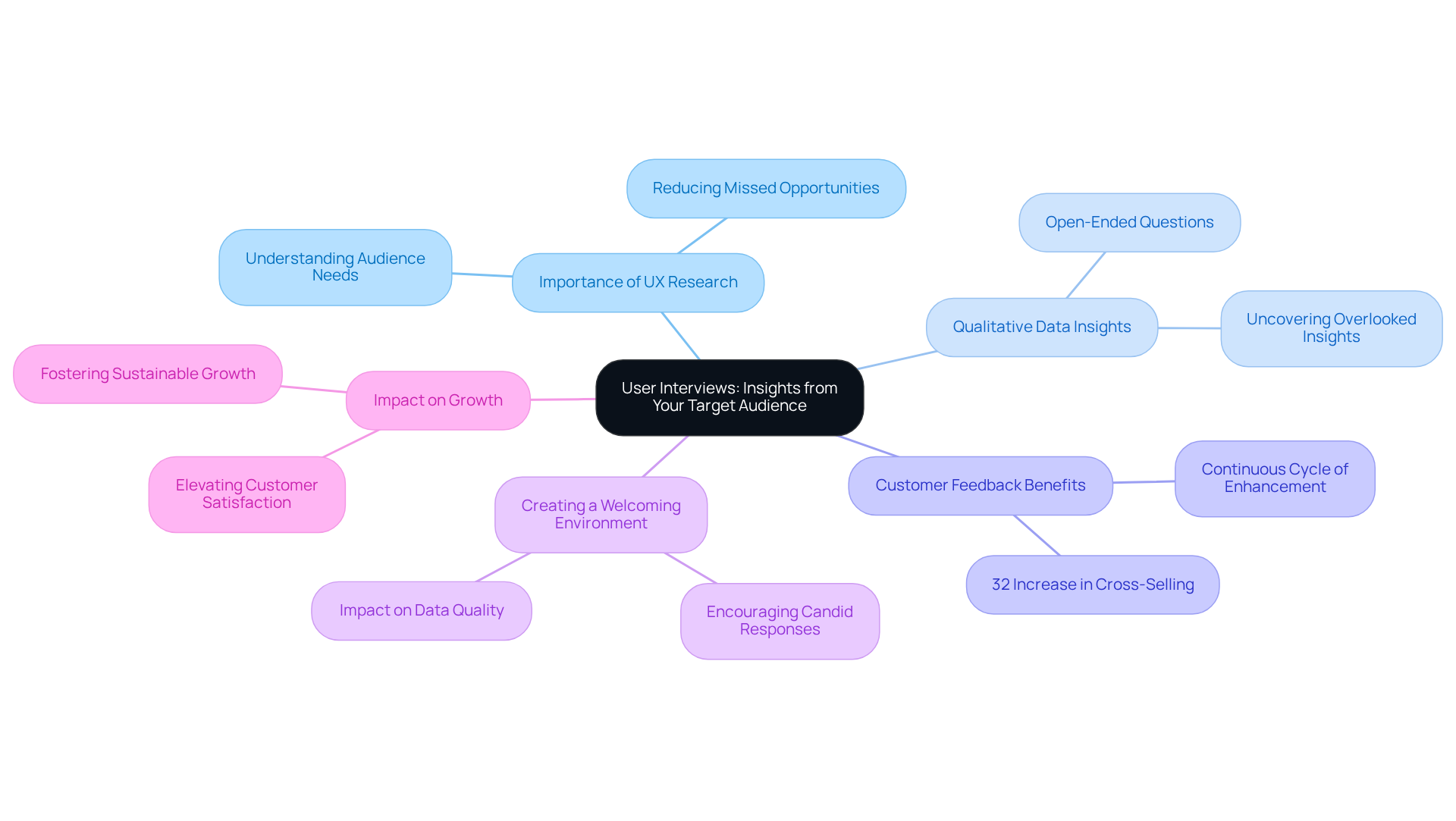
Surveys: Collecting Quantitative Data for Informed Decisions
For many new businesses, the challenge of gathering meaningful feedback can feel overwhelming without employing effective ux research methods. Without clear insights into customer preferences and satisfaction levels, it's difficult to make informed decisions that drive growth using ux research methods. This uncertainty can lead to frustration, as founders may struggle to identify which features to prioritize or how to effectively market their offerings.
However, there is a compassionate solution: utilizing online surveys. By crafting clear and concise questions, startups can reach a broad audience and collect valuable quantitative data. This process involves ux research methods that not only help in understanding customer needs but also foster a sense of connection with the audience. As you examine the responses through ux research methods, you’ll start to recognize trends that can guide your improvements and marketing strategies.
Imagine the relief of having concrete data at your fingertips, enabling you to make informed choices that resonate with your customers. By embracing this approach, you’re not just gathering information; you’re building a community that feels heard and valued. Remember, every response is a step closer to creating a product that truly meets the needs of your audience.
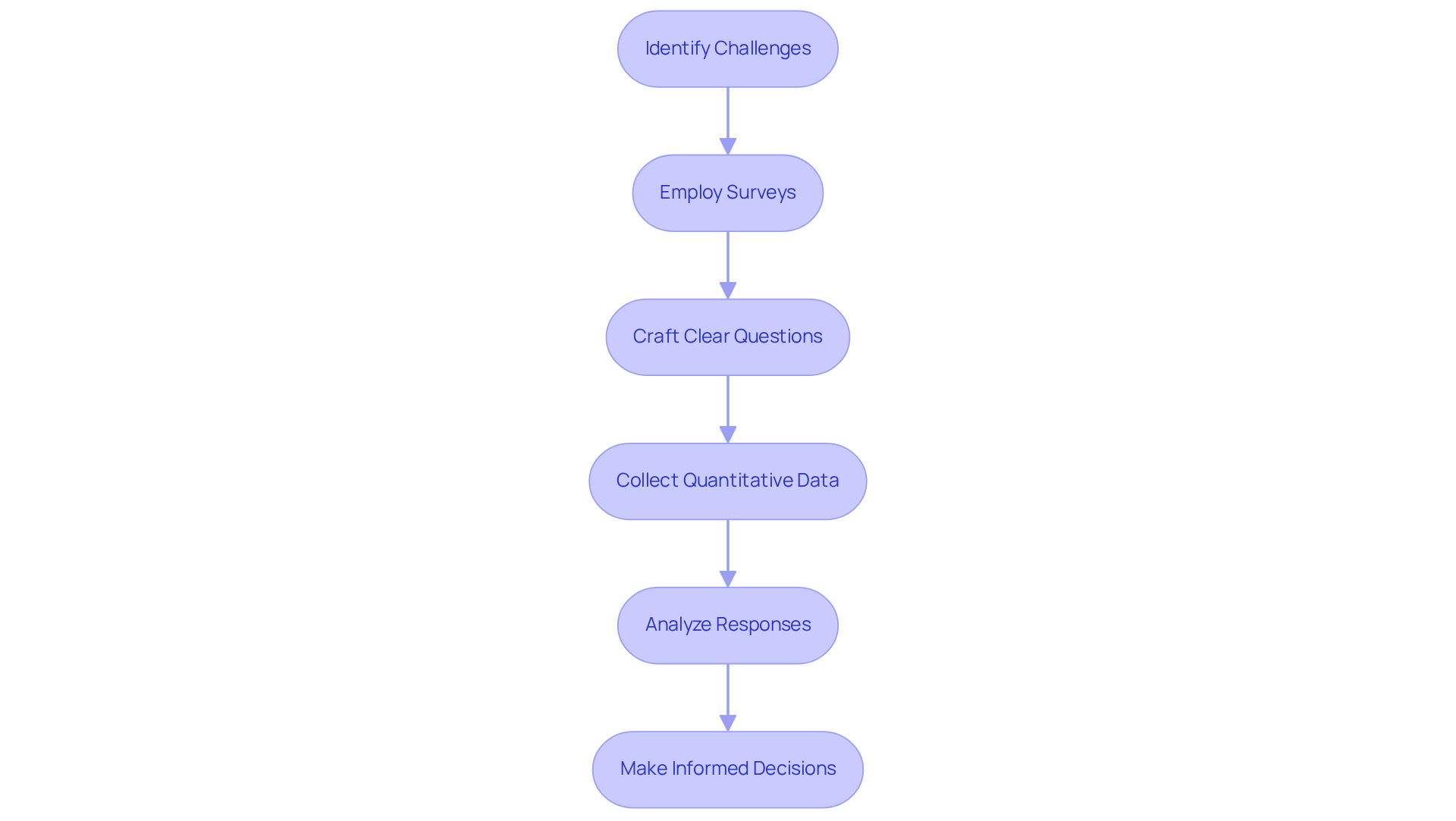
Usability Testing: Evaluating Product Effectiveness with Real Users
Usability testing is a vital process among the ux research methods that involves observing individuals as they interact with a product to identify any challenges they may face. For many startup founders, this can be a daunting task. You might worry about how users will navigate your product or whether they will find it intuitive. These concerns are valid, as usability issues can significantly impact user satisfaction and retention.
Startups have the option to utilize ux research methods to conduct these tests in controlled environments or remotely, which allows for the collection of valuable feedback on navigation, functionality, and overall satisfaction. This iterative process utilizes ux research methods not only to identify problems but also to foster genuine interactions that can lead to meaningful improvements.
By embracing this feedback, you can enhance your product, ultimately creating a more accessible interface that resonates with your users. Remember, every piece of feedback is an opportunity for growth, and your commitment to understanding your users’ experiences is what will set your startup apart.
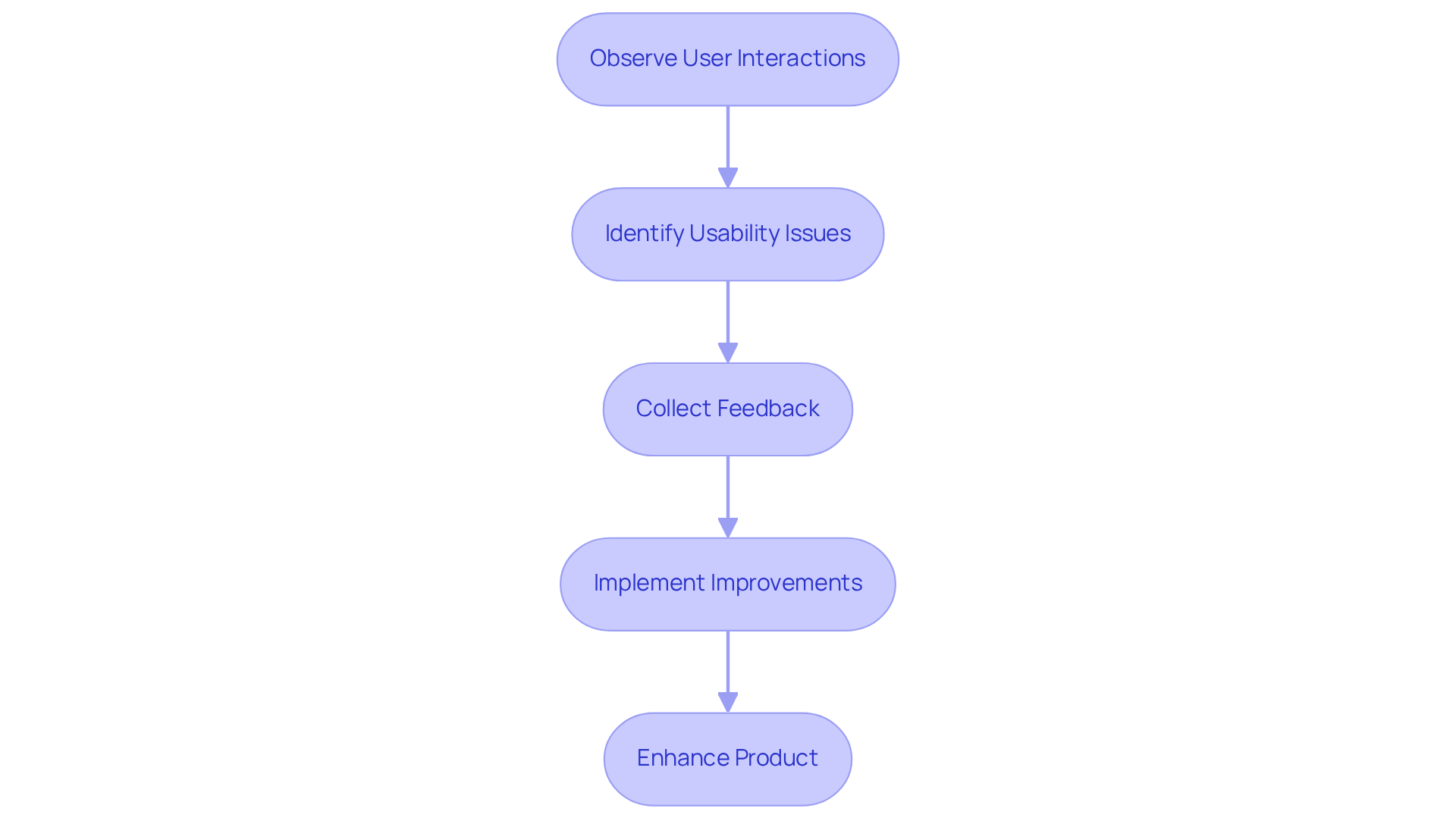
Focus Groups: Gathering Diverse User Perspectives
Focus groups serve as a powerful qualitative research technique, bringing together small groups of individuals to share their experiences and perceptions of a product. This method provides new businesses with a valuable opportunity to explore consumer attitudes and gather insights on specific features or concepts. By fostering open discussion, startups can uncover customer expectations and identify crucial areas for improvement.
Many startup founders may feel overwhelmed by the challenge of understanding their customers' needs. Statistics reveal that 65% of enterprise staff members have noted a growing demand for UX research methods, highlighting the increasing recognition of the importance of feedback. Additionally, businesses that prioritize customer experience can charge a premium of up to 16% for their products and services, showcasing the financial benefits of effective client engagement. Remarkably, every $1 invested in UX yields a return of $100, illustrating the profound financial impact of user-centered design.
It’s encouraging to know that testing with just five participants can reveal 85% of usability issues, making focus groups an invaluable tool for gathering insights early in the design process. Steve Krug wisely points out that testing with a single participant at the project's outset is preferable to waiting until the end to test with 50, emphasizing the critical nature of early feedback.
Conducting successful focus groups requires thoughtful planning, including:
- Setting clear objectives
- Selecting diverse participants
- Creating a welcoming environment that encourages honest feedback
The fact that 91% of dissatisfied clients don’t express their negative experiences further highlights the importance of gathering feedback through focus groups, illustrating the risk of losing customers without their input.
By embracing focus groups as UX research methods, technology companies can significantly enhance their designs, ensuring alignment with consumer needs and expectations. This approach not only aids in refining current features but also inspires innovative solutions that resonate with target audiences, ultimately leading to greater satisfaction and loyalty.
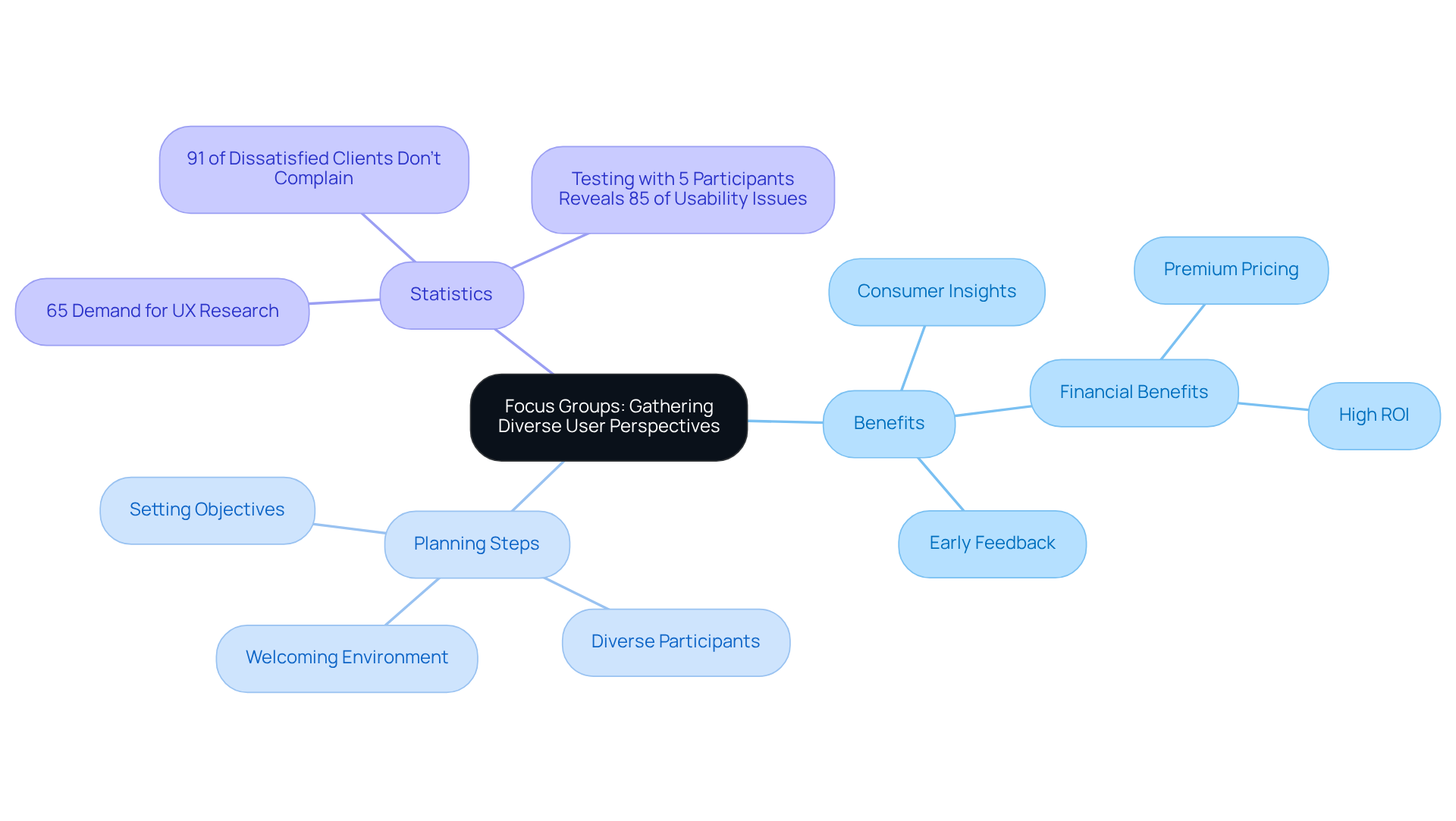
A/B Testing: Optimizing User Experience Through Comparison
Many new businesses face the challenge of understanding what truly resonates with their audience by employing UX research methods. A/B testing emerges as a powerful ally in this journey, enabling startups to compare two variations of a product by presenting them to distinct groups and measuring their responses. This technique can be applied to various design elements, such as layout, color schemes, and call-to-action buttons, helping to identify which version performs better. Imagine the potential impact: a well-conducted A/B test can lead to a remarkable conversion rate increase of up to 400%, as highlighted by Invesp. This illustrates just how crucial UX research methods like A/B testing can be for enhancing engagement and driving business success.
The iterative nature of A/B testing as well as UX research methods fosters a culture of continuous improvement. It empowers new ventures to refine their designs through UX research methods based on real preferences and behaviors. Consider companies like Google, which have embraced A/B testing wholeheartedly, conducting over 7,000 tests in just one year. This practice has become a standard among major tech companies, resulting in significant enhancements to user experience and engagement through the use of UX research methods.
To implement A/B testing effectively, new businesses should utilize UX research methods to start with clear objectives—whether that's increasing page visits or improving purchase completions. Tools like Optimizely or Google Optimize can simplify the process, enabling teams to run tests without needing extensive coding knowledge. However, it’s vital to allow tests to run for an adequate duration—typically around 14 days—to gather enough data for reliable results. It’s worth noting that only one out of eight A/B tests yields significant results, which highlights the challenges in achieving meaningful outcomes.
By concentrating on core offerings and steering clear of superficial changes, startups can truly maximize the effectiveness of their A/B testing efforts through the application of UX research methods. They should also be mindful of common pitfalls, such as halting tests prematurely or lacking clearly defined goals. Ensuring that tests are statistically significant is crucial for obtaining reliable results. This thoughtful approach ultimately leads to improved customer interactions and increased conversion rates, nurturing a stronger connection with their audience.
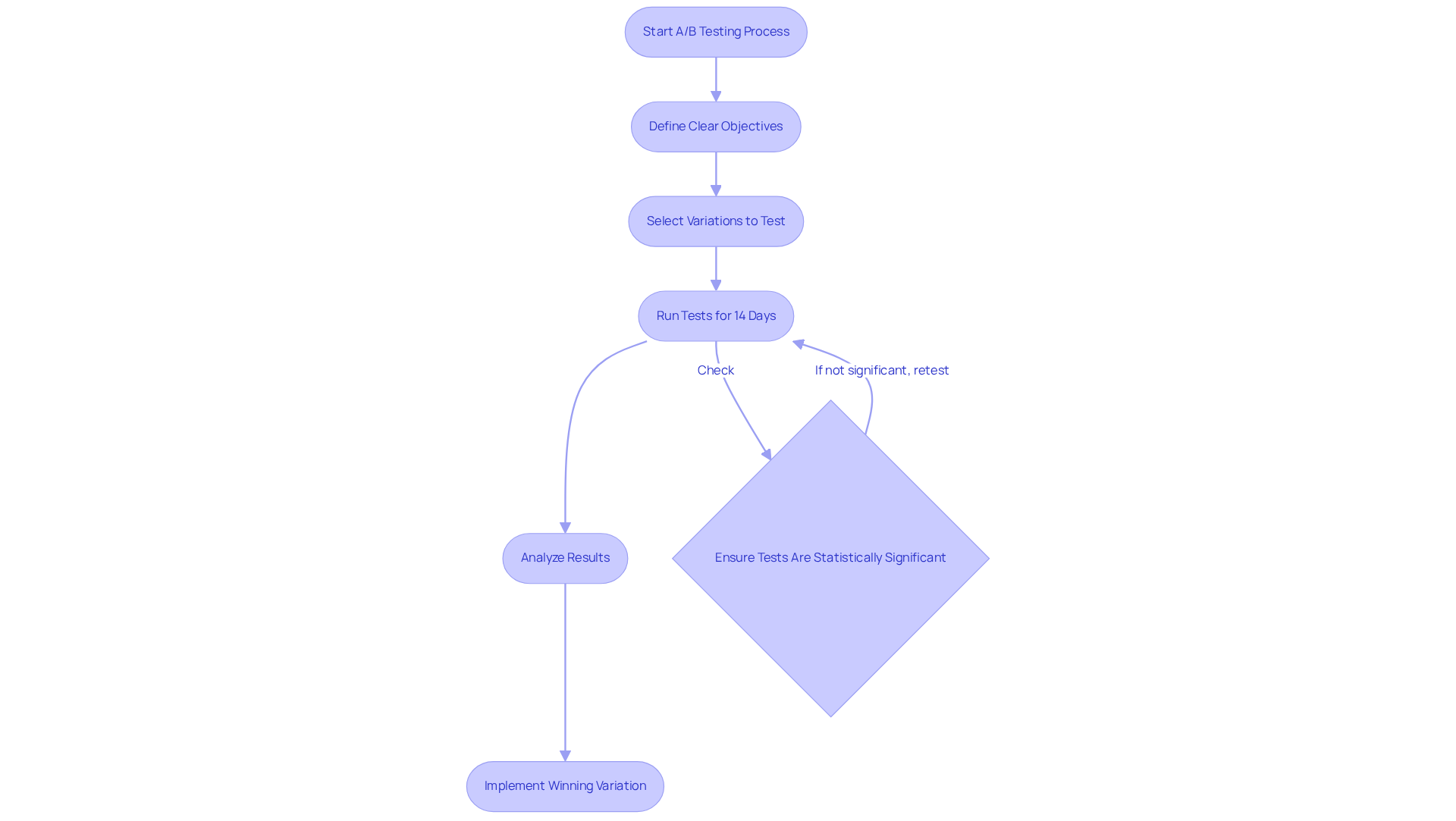
Diary Studies: Capturing Longitudinal User Experiences
Diary studies present a unique challenge for participants, as they require consistent recording of their encounters and interactions with an item over a specified duration. This can feel overwhelming, especially when trying to capture the nuances of behavior, preferences, and challenges in real-time. However, embracing this qualitative approach can lead to invaluable insights that truly enhance understanding. By examining journals for recurring patterns and trends, new ventures can uncover the subtle dynamics of user experiences, which traditional usability testing might miss.
Imagine a scenario where individuals interact with a product in their everyday environments. Diary studies can reveal the intricacies of these interactions, shedding light on motivations and pain points that are often overlooked. This deeper understanding can empower startups to make informed design choices that resonate with their audience. Successful implementations of diary studies have demonstrated that they not only foster self-awareness among participants but also provide actionable insights that drive continuous improvement in user experience.
To ensure the effectiveness of diary studies, it’s essential to align participants' reporting frequency with the nature of the behaviors being studied. Providing clear written instructions and gentle reminders can help maintain engagement, making the process feel less daunting. Additionally, considering participant diversity can enhance data collection, while being mindful of potential dropout challenges in longer studies is crucial. Offering appropriate compensation, such as around $40 per hour, can serve as a motivating factor for participation.
By incorporating diary studies into their broader UX research methods, technology companies can enhance their approaches and cultivate deeper connections with their audience. This nurturing approach not only supports the participants but also enriches the overall understanding of user experiences, creating a community where every voice matters.
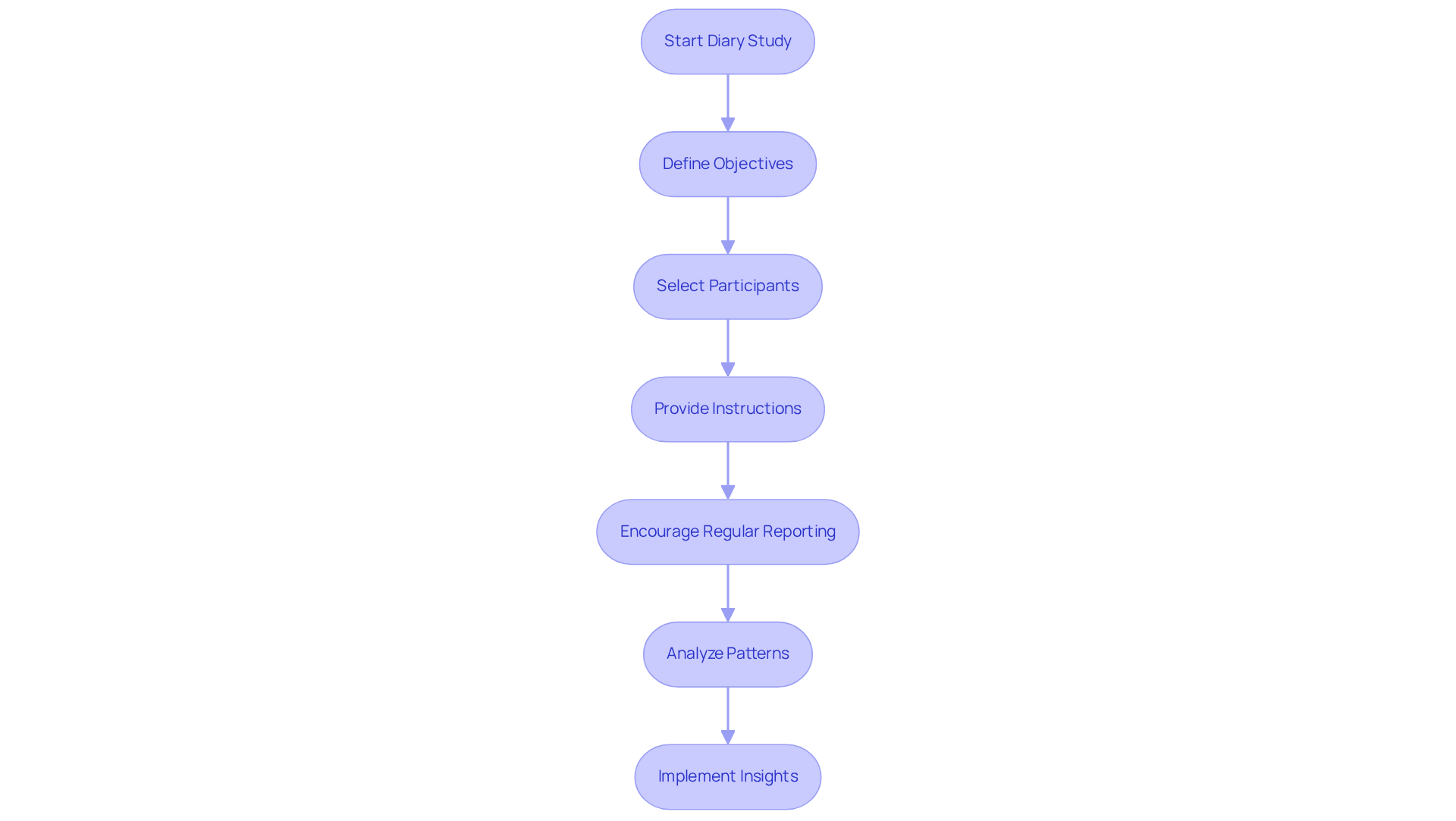
Card Sorting: Structuring Information Based on User Preferences
For many new businesses, understanding how to effectively organize content can feel overwhelming. When content doesn't align with what users expect, it can lead to frustration and confusion, ultimately detracting from the user experience. This is a common struggle that many founders face as they try to navigate the complexities of their audience's needs.
Imagine a potential customer visiting your site, only to find themselves lost in a maze of information that doesn’t resonate with them. This disconnect can lead to missed opportunities and a sense of disconnection from your brand. It’s a painful reality, but one that can be addressed with the right approach.
Card sorting offers a compassionate solution. By inviting individuals to categorize content in a way that makes sense to them, you can gain valuable insights into their cognitive frameworks and preferences. This method not only helps in creating intuitive navigation systems but also aligns the information structure with what your audience truly expects, demonstrating the effectiveness of ux research methods. In doing so, you enhance their overall experience and foster a deeper connection with your brand.
At RNO1, we understand the emotional journey of startup founders. We’re here to support you in transforming these challenges into opportunities for growth and connection. Let’s work together to create a user experience that feels welcoming and intuitive, ensuring your audience feels understood and valued.
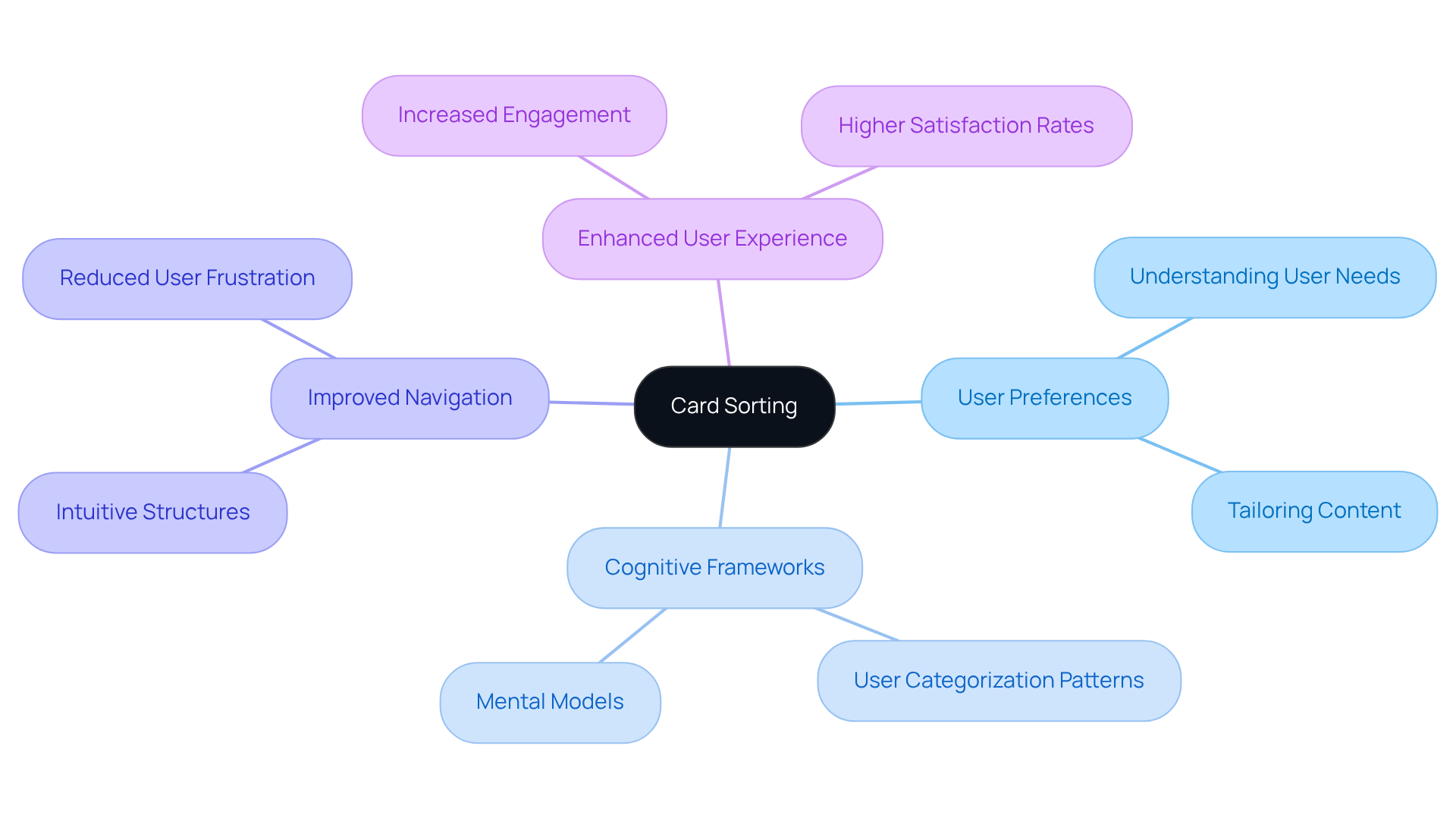
Heatmaps: Visualizing User Interaction Patterns
In the fast-paced world of technology, many startup founders face a common challenge: utilizing UX research methods to understand user engagement on their websites and apps. It can be disheartening to see potential customers visit but not interact with your content as you hoped. Heatmaps emerge as a powerful ally in this struggle, visualizing interactions by capturing where individuals click, scroll, and hover. By utilizing UX research methods to analyze this data, you can uncover which elements draw attention and which are often overlooked, helping you create a more inviting experience.
Consider this: studies from Crazy Egg reveal that a staggering 70% of website visitors don’t scroll past the first two screens. This statistic underscores the critical need to place essential information above the fold. Imagine the impact of ensuring your key messages are seen right away! By utilizing UX research methods and embracing heatmap insights, you can make targeted design enhancements that significantly boost engagement and satisfaction.
Many businesses that have harnessed heatmap analysis report conversion rate enhancements of up to 25%. In fact, 83% of firms using heatmaps as part of their UX research methods indicate improved conversion rates, showcasing the effectiveness of this approach in optimizing client interactions. Take the example of 1-800-Flowers, which experienced a remarkable 20% sales increase after addressing experience issues identified through heatmap data. As Kara Parlin wisely states, "Heat maps can help you identify areas of your content that are most engaging."
By utilizing heatmaps, technology companies can better align their digital products with consumer expectations, fostering meaningful engagement. Remember, you’re not alone in this journey; these tools can help you create a nurturing environment for your users, ensuring they feel valued and understood. Let’s explore how heatmaps can transform your approach and lead to greater success together.
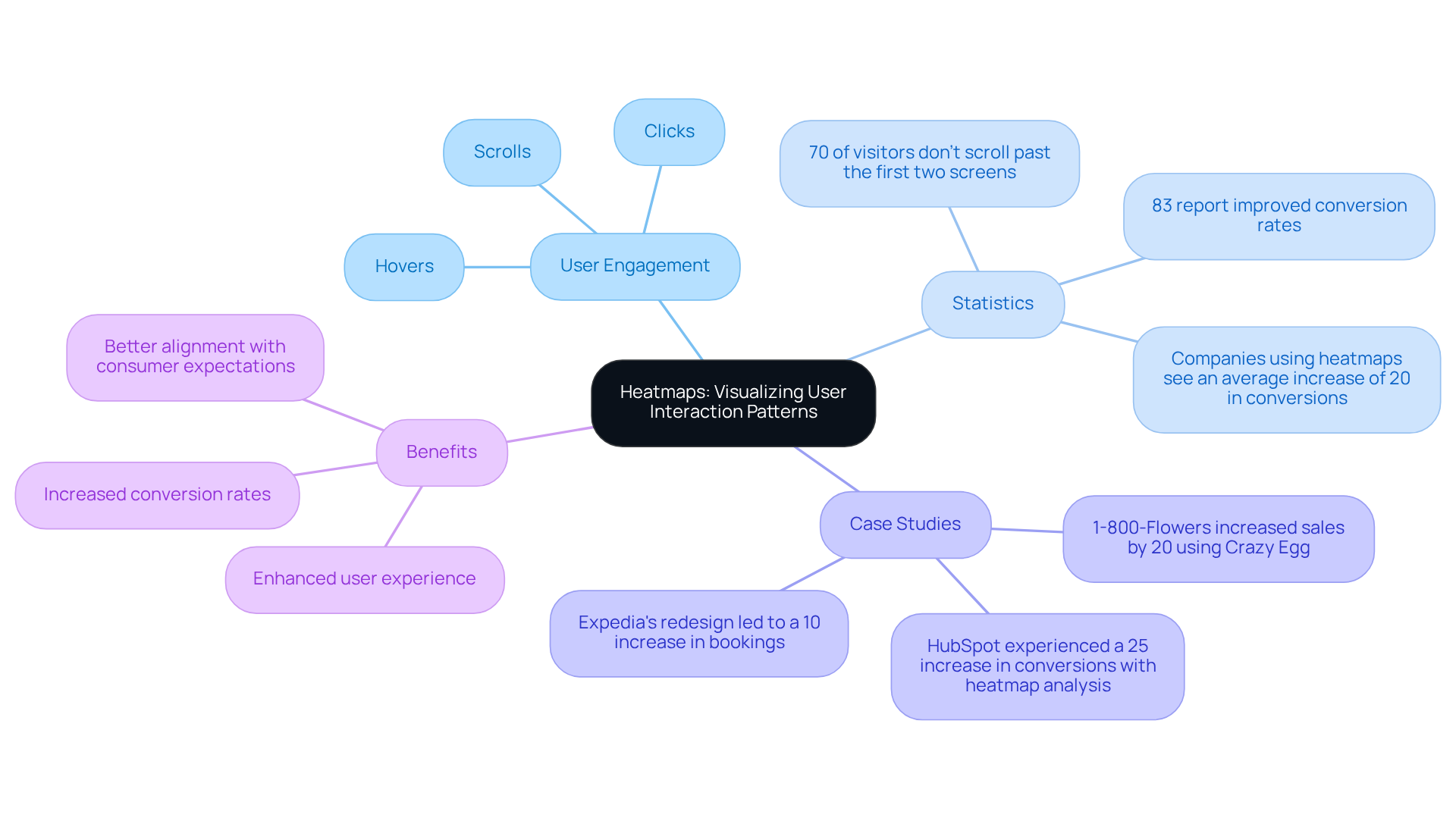
Eye Tracking: Understanding User Attention and Focus
Eye tracking technology addresses a common challenge faced by many startups: understanding what truly captures user attention. This technology records individuals' eye movements, revealing which design elements engage users and which aspects may fall short. By closely examining this data, new businesses can discern the features that effectively captivate interest and those that require enhancement. This knowledge is vital for optimizing layouts, improving content visibility, and ultimately enriching the user experience.
Consider the journey of tech ventures like Underwater Audio. They embraced eye tracking insights, making strategic adjustments that led to a remarkable 35.6% increase in sales. Such transformations underscore the potential of eye tracking to not only boost engagement but also foster a deeper connection with users. Recent advancements in this field, which have progressed significantly since the early 20th century, have rendered eye tracking more accessible and user-friendly. This evolution allows startups to utilize desktop, stationary, and remote eye trackers, empowering them to make informed design decisions that truly resonate with their audience.
Incorporating eye tracking with traditional UX research methods enhances stakeholder confidence in the research findings, making it an invaluable resource for tech startups. By leveraging this technology, founders can gain a more profound understanding of user behavior, paving the way for more effective and engaging digital experiences. Eye tracking not only informs design strategies but also nurtures a sense of community and support, guiding startups toward success in their endeavors.
![]()
Conclusion
Tech startups often encounter numerous challenges as they endeavor to develop products that truly resonate with their audiences. The need to understand user needs and preferences is not merely advantageous; it is vital for achieving success in today’s competitive environment. By embracing comprehensive UX research methods, startups can uncover invaluable insights that inform product development, enhance user experience, and ultimately foster business growth.
In this article, we have explored various UX research techniques, such as:
- User interviews
- Surveys
- Usability testing
- Focus groups
- A/B testing
- Diary studies
- Card sorting
- Heatmaps
- Eye tracking
Each method presents unique benefits, from collecting qualitative feedback to analyzing user interactions and refining design choices. By integrating these strategies, tech startups can cultivate a supportive atmosphere that nurtures innovation, customer satisfaction, and loyalty.
The importance of effective UX research is profound. Startups prioritizing user understanding are better equipped to navigate the complexities of product development and market demands. By embracing these research methods, not only do they enhance user experience, but they also position themselves for long-term success. As the tech landscape continues to evolve, leveraging these insights will be crucial for startups aiming to create impactful products that genuinely meet the needs of their audiences. We encourage you to take these steps, knowing that the journey toward understanding your users is a path filled with potential and promise.
Frequently Asked Questions
What are the main challenges tech startups face in product development?
Tech startups often struggle to understand their users' true needs and navigate the complexities of product development, leading to frustration and a disconnect from their audience.
How does RNO1 support tech startups in their UX research?
RNO1 offers a diverse array of UX research methods that emphasize user-centered design principles, iterative testing, and data-driven decision-making to help startups create products that resonate with their intended audience.
What benefits does a user-centered design approach provide?
A user-centered design approach enhances customer satisfaction and loyalty, ultimately driving business success and helping new businesses maintain a competitive edge in the technology landscape.
How can advanced analytics benefit new businesses?
Advanced analytics allow new businesses to continuously refine their offerings by effectively adapting to user feedback and market trends.
What services does RNO1 provide to startups?
RNO1 provides services including Digital Strategy, UX & UI Design, and Web & App Development, tailored to address the unique challenges of new businesses, such as time and budget constraints.
What role do client interviews play in UX research?
Client interviews provide direct insights into clients' experiences and expectations, helping startups understand their audience better and refine their offerings.
How can open-ended questions in interviews benefit startups?
Open-ended questions encourage participants to share their thoughts freely, yielding qualitative data that uncovers insights often overlooked by quantitative methods.
What is the impact of prioritizing customer insights for businesses?
Companies that prioritize customer insights can achieve a 32% increase in cross-selling and up-selling, highlighting the tangible benefits of integrating consumer feedback into the development process.
Why is creating a welcoming interview environment important?
A welcoming interview environment influences the quality of responses, making clients feel comfortable to share candidly, which enriches the data collected.
How can online surveys aid tech startups?
Online surveys help startups gather meaningful feedback by crafting clear and concise questions, enabling them to collect valuable quantitative data and understand customer preferences and satisfaction levels.
What is the significance of analyzing survey responses?
Analyzing survey responses helps startups recognize trends that can guide improvements and marketing strategies, allowing for informed decisions that resonate with customers.




